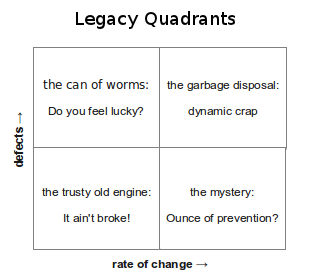Your legacy system presents you with a choice: Put a stake in the ground and attempt to do something about the daily pain it causes, or let it get incrementally and certainly worse. Often its challenges seem insurmountable–small improvements appear like ripples in the ocean. Perhaps an investment to improve the software product is not worth the return in value, given its future.
Chances are that most of the time, though, you’ll be stuck with your legacy system for some time coming, and it makes sense to put a foot down to stem the degradation. Working Effectively With Legacy Code provides you with primarily tactical guidance for preventing entropy, focusing mostly on individual code-level challenges. The Mikado Method provides you with primarily strategic guidance, focusing mostly on managing large-scale refactorings across a code base (legacy or not).
In terms of where to put your effort, the best strategy is always to begin with the areas of current impact–what needs to change for the feature you’re currently tackling? But if you can afford additional effort to add characterization tests–i.e. increase “confidence coverage”–consider this quadrant that pits rate of change against defects for a given class.

How might you determine what classes belong in which quadrants? Tim Ottinger devised a heat map while at one shop, a simple Python tool that cross-referenced JIRA tickets with trouble tickets reported in Git. (I got to help build it!) You might consider filtering the defects to ignore those with low severity.
The Trusty Old Engine. “If it ain’t broke, don’t fix it!” Classes that work and aren’t changing should be the last thing you worry about. Sometimes code in these areas is tempting: it may exhibit obvious duplication, for example, that a refactoring weenie might view as a quick-win opportunity. Don’t waste your time–there are bigger fish to try.
The Can of Worms. You should have very few classes in this quadrant–having lots of stable classes that exhibit many defects suggests a reset on how your team does triage. Fixing these troubled classes might seem like opportunity to make your customer happy. Open the code up, however, and you’re likely to find fear-inspiring code. You might view this quadrant as a sandbox for ramping up on legacy code techniques: Classes here will provide you the time to experiment without having to worry as much about contention issues with the rest of the team.
The Mystery. Getting all the tiny bits correct in the face of rapid change is a significant challenge. A single, low-defect class with lots of change could suggest at least a couple things: The changes are generally trivial in nature, or the class rampantly violates single responsibility principle (for example, a large controller class that doesn’t simply delegate but also does work). With respect to the latter, perhaps you’ve been fortunate so far, or perhaps you have good test coverage.
It might be worth a small amount of effort to prevent any future problems in such an SRP-violating class. The nice thing is that splintering off new classes can be a fairly quick and risk-free effort, one that should begin to isolate areas of risk. You might then be able to code a few key characterization tests without extreme difficulty.
The Garbage Disposal. Usually there are at least a few classes in your system that are very large and fraught with problems, and they change all the time. This is the obvious place to improve your confidence coverage.
Good design, which starts with the application of the SRP, starts to solve many problems that the garbage disposal represents. Small, single-purpose classes provide more opportunities for reuse, make performance profiling easier, expose defects more readily, and can dramatically improve comprehension of the code, to name a few benefits. A garbage disposal is a dangerous place–with lots of hands in one big sinkhole, contention is frequent and merges can be painful. Design that adheres to the SRP thus also makes continuous integration easier.

